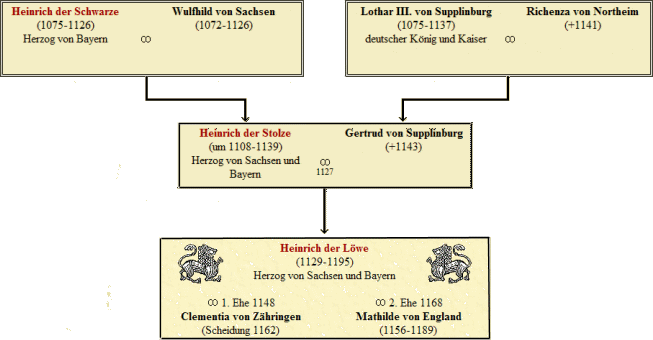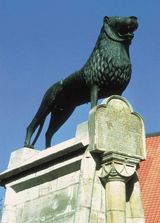
Here we are at the entrance to Burgplatz: since the 9th century, this was the seat of the Brunon princes. Duke Henry the Lion developed the Burgplatz into the centre of Guelph power in the 12th century. The Burgplatz, bordered by the castle, the cathedral, the classicist "Vieweghaus" and beautiful half-timbered buildings, still shows the medieval layout. The lion statue stands in the centre of the square.
Braunschweig, at the Burgplatz

Dankwarderode Castle was the residence of Henry the Lion. The present building was reconstructed and rebuilt on the ground plan of the duke's hall, which was built in 1175, from 1887 onwards on the basis of archaeological investigations.
In the northern part of the Burgplatz stands the Huneborstel House, now the Gildehaus. It was built in 1901 using the original parts of the Sack 5 house (around 1530).
Figures at the town hall
The town hall of the city of Braunschweig is located very close to Burgplatz. The town hall is documented as far back as 1253. The neo-Gothic building was erected between 1894 and 1900.
The town hall stands out in the cityscape because of its 61 m high tower, which was built according to Flemish models.

The Gewandhaus on the Altstadtmarkt in Braunschweig originally served as a storage, sales and guild house for the Guild of Garment Cutters.
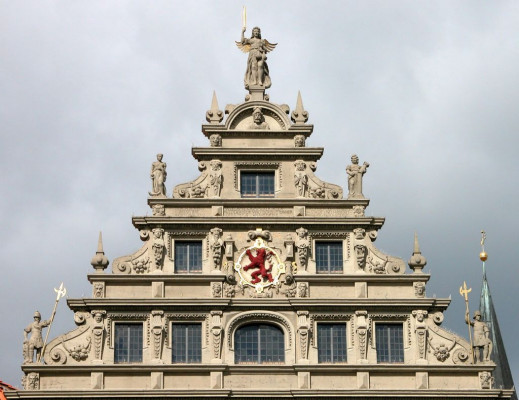
The 16th century east gable in Renaissance style is one of the most important works of Renaissance architecture in Lower Saxony.
![]() Click on the picture!
Click on the picture!

The collegiate church of St. Blasii, today an Evangelical Lutheran cathedral.
1172 Henry the Lion sets out on a pilgrimage to the Holy Land.
1173 marks the start of construction of Brunswick Cathedral after Henry the Lion's happy return.
From 1173 to 1195 the cathedral is built as a three-nave vaulted basilica in place of an older structure. The cathedral is the first fully vaulted building in Lower Saxony.
Henry the Lion designates this church as his burial place, where he is also buried next to his wife Mathilde in 1195. Initially built as a three-nave basilica, it has been
rebuilt, extended and reconstructed several times up to the present day. The most important furnishings include the altar of the Virgin Mary (1188), the seven-branched
candelabrum (c. 1170/80) and the crucifix carved from wood by the master Imervard (2nd half of the 12th century), as well as the tomb of Henry the Lion and Mathilde. This tomb
in the nave of the cathedral, made of shell limestone around 1250, is considered a major work of medieval stone sculpture.
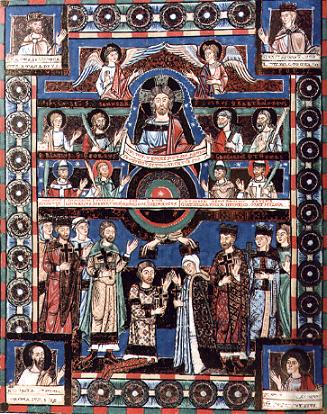
The Evangeliary is one of the great creations of Romanesque book art. It is an impressive testimony to the dynastic claim and the high self-confidence of Duke Henry the Lion. The book, commissioned by him for the altar of the Virgin Mary, is the only 12th century liturgical manuscript of the Gospels from the Hohenstaufen period to have survived as a donation from a ruler. Duke Henry the Lion, together with his wife Mathilde, dedicated it to Brunswick Cathedral, which was built from 1173 onwards, on the occasion of the consecration of the Marian altar in 1188. As can be seen from the manuscript's name, Evangeliar, it contains the words of the Gospel.
In the lower half of the coronation painting, Duke Henry the Lion kneels in the centre left, facing him is his second wife Matilda of England. Henry and Matilda are dressed in precious robes, each holding a golden cross. Behind Henry the Lion stands his father Henry the Proud and his mother Gertrude, then their father Emperor Lothar III and his wife Richenza, i.e. Henry the Lion's grandparents. Behind Matilda are her father King Henry II of England, his mother Queen Matilda and an unknown person. The crowns Christ hands out from heaven are to be interpreted as the crowns of eternal life rather than those of temporal rule. The crowns of eternal life are referred to in the texts on the banners of the half-figures in the corner fields of the depiction. The dedicatory poem of the Gospels states that Duke Henry and Matilda dedicated "this golden book" to Christ in the hope of eternal life.
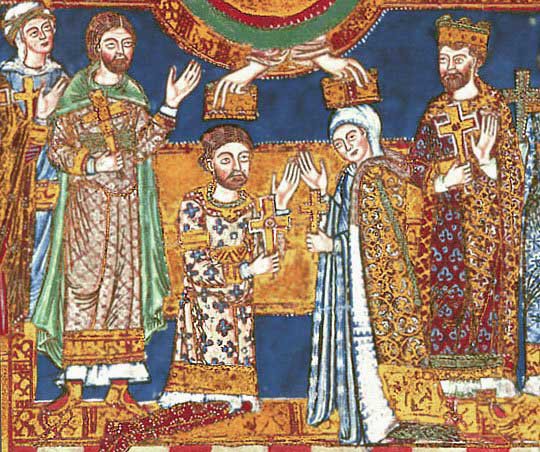
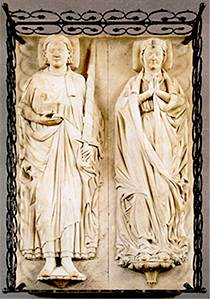

The Tomb of Henry the Lion and Duchess Mathilde
In the second nave bay are the life-size sculptures of the ducal couple facing east, the place of the Last Judgement and the Resurrection, as is customary for medieval tombs. The tomb was commissioned by Count Palatine Heinrich (c. 1173/1227) for his father. It can be assumed that it was completed for the consecration of the cathedral in 1226.
While most tombs of this time have a standing figure placed on a slab, here an attempt is made to depict reclining people. Thus, the fabric here follows gravity in many details, which can be seen very nicely in the robes of the couple. Various details are also very lovingly treated, such as the cushions under the heads, which seem to be made of soft material, or the consoles at the feet of the couple, which are decorated with foliage.
With these sculptures, the artist has created the ideal image of a princely couple, for he had probably hardly known Henry and Mathilde personally; they had been dead for about thirty years. Heinrich is depicted as a young ruler and carries the sign of his rule, the sword, in his left hand, the model of Braunschweig Cathedral in his right.

In search of Gertrud:
Gertrud von Supplinburg was often in Braunschweig. After all, she came from here. But she is not buried here.
Here we find the tomb of her son Henry the Lion with his second wife Matilda of England. She was the sister of Richard I the Lionheart (1157 - 1199). Ernst August of Hanover is a direct descendant of Henry the Lion and related to the English royal family through his wife Matilda of England.
